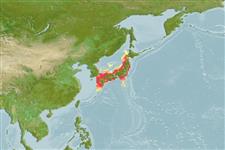Add your observation in Fish Watcher
| Native range | All suitable habitat | Point map | Year 2050 |

|
| This map was computer-generated and has not yet been reviewed. |
| Trachurus japonicus AquaMaps Data sources: GBIF OBIS |
Upload your photos and videos
Pictures | Google imageTrachurus japonicus
Picture by Shao, K.T.
Pictures | Google imageTrachurus japonicus
Picture by Shao, K.T.
Korea (South) country information
Common names:
Chǒn-gaeng-i, Japanese horse mackerel, 전갱이
Occurrence: native
Salinity: marine
Abundance: | Ref:
Importance: commercial | Ref: FAO, 1994
Aquaculture: | Ref:
Regulations: | Ref:
Uses: no uses
Comments: Reported from the coastal waters of Gadeok-do (Ref. 37629) and Tongyeong (Ref. 49924), and Suyoung Bay (Ref. 37630). Also Ref. 559.
National Checklist:
Country Information: https://www.cia.gov/library/publications/resources/the-world-factbook/geos/ks.html
National Fisheries Authority:
Occurrences: Occurrences Point map
Main Ref: Kim, I.S., Y. Choi, C.L. Lee, Y.J. Lee, B.J. Kim and J.H. Kim, 2005
National Database:
Occurrence: native
Salinity: marine
Abundance: | Ref:
Importance: commercial | Ref: FAO, 1994
Aquaculture: | Ref:
Regulations: | Ref:
Uses: no uses
Comments: Reported from the coastal waters of Gadeok-do (Ref. 37629) and Tongyeong (Ref. 49924), and Suyoung Bay (Ref. 37630). Also Ref. 559.
National Checklist:
Country Information: https://www.cia.gov/library/publications/resources/the-world-factbook/geos/ks.html
National Fisheries Authority:
Occurrences: Occurrences Point map
Main Ref: Kim, I.S., Y. Choi, C.L. Lee, Y.J. Lee, B.J. Kim and J.H. Kim, 2005
National Database:
Common names from other countries
Classification / Names Common names | Synonyms | Catalog of Fishes(genus, species) | ITIS | CoL | WoRMS | Cloffa
Teleostei (teleosts) > Carangiformes (Jacks) > Carangidae (Jacks and pompanos) > Caranginae
Etymology: Trachurus: Greek, trachys, -eia, -ys = rough + Greek, oura = tail (Ref. 45335).
More on authors: Temminck & Schlegel.
Etymology: Trachurus: Greek, trachys, -eia, -ys = rough + Greek, oura = tail (Ref. 45335).
More on authors: Temminck & Schlegel.
Environment: milieu / climate zone / depth range / distribution range Ecology
Marine; pelagic-neritic; oceanodromous (Ref. 51243); depth range 0 - 275 m (Ref. 54927), usually 50 - 275 m (Ref. 54927). Tropical; 46°N - 13°N, 105°E - 148°E
Distribution Countries | FAO areas | Ecosystems | Occurrences | Point map | Introductions | Faunafri
Northwest Pacific: southern Japan, Korean Peninsula to the East China Sea. Pacific Ocean off the coast of southeast Asia.
Length at first maturity / Size / Weight / Age
Maturity: Lm 19.0, range 18 - 20 cm
Max length : 50.0 cm TL male/unsexed; (Ref. 56557); common length : 35.0 cm TL male/unsexed; (Ref. 56557); max. published weight: 660.00 g (Ref. 40637); max. reported age: 12 years (Ref. 56557)
Max length : 50.0 cm TL male/unsexed; (Ref. 56557); common length : 35.0 cm TL male/unsexed; (Ref. 56557); max. published weight: 660.00 g (Ref. 40637); max. reported age: 12 years (Ref. 56557)
Short description Identification keys | Morphology | Morphometrics
Dorsal spines (total): 9; Dorsal soft rays (total): 30 - 35; Anal spines: 3; Anal soft rays: 26 - 30; Vertebrae: 24. Species with no finlets and the entire lateral line with scutes (69-73) (Ref. 41299).
Adults occur on continental waters (Ref. 41299). Pelagic (Ref. 52947). Juveniles associate with drifting seaweed (Ref. 12114, 12115).
Life cycle and mating behavior Maturity | Reproduction | Spawning | Eggs | Fecundity | Larvae
Main reference
Upload your references | References | Coordinator : Smith-Vaniz, William F. | Collaborators
Masuda, H., K. Amaoka, C. Araga, T. Uyeno and T. Yoshino, 1984. The fishes of the Japanese Archipelago. Vol. 1. Tokai University Press, Tokyo, Japan. 437 p. (text). (Ref. 559)
IUCN Red List Status (Ref. 130435: Version 2024-2)
Near Threatened (NT) (A2bd); Date assessed: 20 July 2017
Threat to humans
Harmless
Human uses
Fisheries: highly commercial; aquaculture: commercial
FAO(Aquaculture systems: production; Fisheries: production, species profile; publication : search) | FishSource | Sea Around Us
More information
Population dynamics
Growth parameters
Max. ages / sizes
Length-weight rel.
Length-length rel.
Length-frequencies
Mass conversion
Recruitment
Abundance
Growth parameters
Max. ages / sizes
Length-weight rel.
Length-length rel.
Length-frequencies
Mass conversion
Recruitment
Abundance
Anatomy
Gill area
Brain
Otolith
Gill area
Brain
Otolith
Physiology
Body composition
Nutrients
Oxygen consumption
Swimming type
Swimming speed
Visual pigments
Fish sound
Diseases & Parasites
Toxicity (LC50s)
Body composition
Nutrients
Oxygen consumption
Swimming type
Swimming speed
Visual pigments
Fish sound
Diseases & Parasites
Toxicity (LC50s)
Human related
Aquaculture systems
Aquaculture profiles
Strains
Ciguatera cases
Stamps, coins, misc.
Aquaculture systems
Aquaculture profiles
Strains
Ciguatera cases
Stamps, coins, misc.
Tools
E-book | Field guide | Length-frequency wizard | Life-history tool | Point map | Classification Tree
| Catch-MSY |
Special reports
Download XML
Internet sources
Aquatic Commons | BHL | Cloffa | BOLDSystems | Websites from users | Check FishWatcher | CISTI | Catalog of Fishes(genus, species) | DiscoverLife | ECOTOX | Faunafri | Fishtrace | GenBank(genome, nucleotide) | GloBI | GOBASE | | Google Books | Google Scholar | Google | IGFA World Record | MitoFish | National databases | Otolith Atlas of Taiwan Fishes | PubMed | Reef Life Survey | Scirus | SeaLifeBase | Tree of Life | Wikipedia(Go, Search) | World Records Freshwater Fishing | Zoological Record
Estimates based on models
Preferred temperature (Ref. 115969): 1.8 - 22, mean 13.8 (based on 75 cells).
Phylogenetic diversity index (Ref. 82804): PD50 = 0.5001 [Uniqueness, from 0.5 = low to 2.0 = high].
Bayesian length-weight: a=0.01096 (0.00923 - 0.01302), b=2.97 (2.94 - 3.00), in cm Total Length, based on LWR estimates for this species (Ref. 93245).
Trophic level (Ref. 69278): 3.4 ±0.45 se; based on food items.
Resilience (Ref. 120179): Medium, minimum population doubling time 1.4 - 4.4 years (K=0.14-0.38; tmax=6).
Prior r = 0.55, 95% CL = 0.36 - 0.82, Based on 1 full stock assessment.
Fishing Vulnerability (Ref. 59153): Moderate vulnerability (35 of 100).
Climate Vulnerability (Ref. 125649): Low vulnerability (20 of 100).




